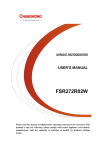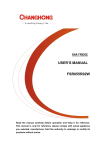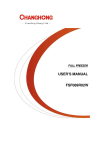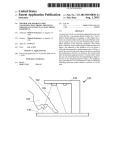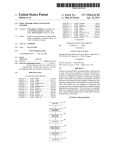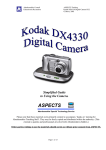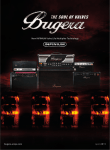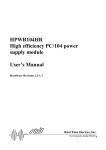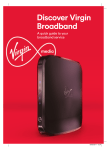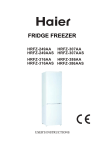Download Refrigerator - KIL320BFMD
Transcript
USER MANUAL REFRIGERATOR MODEL:KIL320BFWD KIL320BFMD SAFETY WARNING! It is hazardous for anyone other than authorized service personnel to carry out servicing or repairs which involves the removal of covers. To avoid the risk of an electric shock do not attempt to repair this appliance yourself. Safety tips Do not use electrical appliances such as a hair dryer or heater to defrost your Fridge/Freezer. Containers with flammable gases or liquids can leak at low temperatures. Do not store any containers with flammable materials, such as spray cans, fire extinguisher refill cartridges etc. in the Fridge/Freezer. Do not place carbonated or fizzy drinks in the Freezer compartment. Ice lollies can cause “Frost/Freeze burns”. If consumed straight from the Fridge/Freezer. Do not remove items from the Fridge/Freezer compartment if your hands are damp/wet, as this could cause skin abrasions or “Frost/Freezer burns”. Bottles and cans must not be placed in the Freezer compartment as they can burst when the contents freeze. Manufacturer’s recommended storage times should be adhered to. Refer to relevant instructions. Do not allow children to tamper with the controls or play with the Fridge/Freezer. The Fridge/Freezer is heavy. Care should be taken when moving it. It is dangerous to alter the specification or attempt to modify this product in any way. Do not store inflammable gases or liquids inside you Fridge/Freezer. If the power cable is damaged, it must be replaced by the manufacturer, its service agent or similarly qualified persons in order to avoid a hazard. Children should be supervised to ensure that they do not play with the appliance. This appliance is not intended for use by persons (including children) with the reduced physical, sensory or mental capabilities, or lack of experience and knowledge, unless they have been given supervision or instruction concerning use of the appliance by a person responsible for their safety. This appliance is intended to be used in household and similar applications such as ·staff kitchen areas in shops, offices and other working environments; ·farm houses and by clients in hotels, motels and other residential type environments; ·bed and breakfast type environments; ·catering and similar non-retail applications. Keep ventilation openings, in the appliance enclosure or in the built-in structure, clear of obstruction. Do not use mechanical devices or other means to accelerate the defrosting process, other than those recommended by the manufacturer. Do not damage the refrigerant circuit. Do not use electrical appliances inside the food storage compartments of the appliance, unless they are of type recommended by the manufacturer. Disposal Old appliances still have some residual value. An environmentally friendly method of disposal will ensure that valuable raw materials can be recovered and used again. The refrigerant used in your appliance and insulation materials requires special disposal procedures. Ensure that none of the pipes on the back of the appliance are damaged prior to disposal. Up to date information concerning options for disposing of your old appliance and packaging from the new one can be obtained from your local council office. Locks If your Fridge/Freezer is fitted with a lock, to prevent children being entrapped keep the key out of reach and not in the vicinity of the appliance. If disposing of an old Fridge/Freezer break off any old locks or latches as a safeguard. 1 INTRODUCTION Before use Please read these instructions and the Safety guidelines on page 1 carefully before using your new Fridge/Freezer. The Fridge/Freezer is for indoor, domestic use only. No Description 1 Refrigerator shelf 2 Vegetable box cover 3 Vegetable box 4 Upper Freezer drawer 5 Bottom Freezer drawer 6 Upper refrigerator door shelf 7 Water tank 8 Small refrigerator door shelf 9 Water tray 10 Water tray cover 11 Door handle 2 INSTALLATION Location When selecting a position for your Fridge/Freezer you should make sure the floor is flat and firm, and the room is well ventilated with an average room temperature of between 16℃ and 32℃. Avoid locating your Fridge/Freezer near a heat source, eg, cooker, boiler or radiator. Also avoid direct sunlight in out-buildings or sun lounges. If you are placing your Fridge/Freezer in an out-building such as a garage or annex ensure that the Fridge/Freezer is placed above the damp course, otherwise condensation will occur on the Fridge/Freezer cabinet. Never place the Fridge/Freezer in a wall recessed or into fitted cabinets or fumiture when your Fridge/Freezer is working, the grille at the back may become hot and the sides warm. It must therefore be installed so that the back of the Fridge/Freezer has at least 9cm(31/2”) of free space and the sides have 2cm(3/4”). Do not drape the Fridge/Freezer with any covering. Leveling the Fridge/Freezer If the Fridge/Freezer is not level, the door and magnetic seal alignment will be affected and may cause you Fridge/Freezer to work incorrectly. Once the Fridge/Freezer is placed in its final location, adjust the leveling feet at the front by turning them. Install outside handle a.Remove the screws from the left side of door with a screwdriver, b.fix the handle with screws on the left side of door by screwdriver and then put the screw cap on the screws.Put away the plastic hole cover for future demand . 3 Cleaning before use Wipe the inside of the Fridge/Freezer with a weak solution of bicarbonate of soda. Then rinse with warm water using a damp sponge or cloth. Wash the baskets and shelves in warm soapy water and dry completely before replacing in the Fridge/Freezer. The external parts of the Fridge/Freezer can be cleaned with wax polish. See page 12 for more details on cleaning. Before plugging in YOUMUST Check that you have a socket which is compatible with the plug supplied with the Fridge/Freezer. If not see the section called ELECTRICAL INFORMATION on page 18. Before switching on! DO NOT SWITCH ON UNTIL FOUR HOURS AFTER MOVING THE FRIDGE/FREEZER. The coolant fluid needs time to settle. If the appliance is switched off at any time, wait 30 minutes before switching back on to allow the coolant fluid to settle. Before filling your Fridge/Freezer Before storing foods in your Fridge/Freezer, turn the Fridge/Freezer on and wait for 24 hours, to make sure it is working properly and to allow the Fridge/Freezer to fail to the correct temperature. See page 7 for more details. START Switching on your Fridge/Freezer 1. Before connecting the Fridge/Freezer to the mains supply position. The thermostat control dial is located inside the Fridge compartment. 2. Turn the thermostat knob to the “3” position and turn on the electricity. The compressor and the light inside the refrigerator will begin to work. 3. Wait 24 hours before placing food into the Fridge/Freezer, the temperature inside your Fridge/Freezer will then be cool enough to chill and freeze foods sufficiently. Adjusting the temperature 1. The temperature in the refrigerator and freezer compartment is controlled by the temperature controller installed on the inside wall of the refrigerator compartment. We strongly recommend you use a freezer thermostat to check that the temperature is below -18 centigrade 4 before loading any food. This can take 2-3 hours. 2. The marks on the knob are the temperature grades, NOT the exact degrees of temperature. “0” is “OFF” AND “7” represents the lowest temperature. 3. Please start with the knob set to position “4”. Use a suitable thermometer to check the temperature after two hours. The refrigerator temperature should be set between +2℃ and +5℃ and the freezer will vary between -18 and -25 degrees centigrade over a typical cycle. To reduce the refrigerator temperature turns the knob towards”6” and check after one hour. NOTE: The Fridge/Freezer may not operate at the correct temperature if it is in a particularly hot or cold room or is you open the Fridge/Freezer door too often. Super Freezing 1. Quick freezing allows moisture inside foodstuffs to form fine ice-crystals which prevent the cell membrane from being damaged and the cytoplasm being lost when unfreezing, thus the original freshness and nutrition constituent of foodstuffs can be retained. 2. Fresh meal and fish to be stored for long time must be done by quick freezing. To quick freeze turn the temperature knob to setting “6” before adding food. NOTE: the maximum allowable capacity is 3KG at a time. 3. After quick freezing, turn the knob back to the original position (Normally time for quick freezing shall not exceed 4 hours). Is the Freezer/Fridge cold enough? If you are at all concerned that your Fridge/Freezer is not being kept cold enough, or you occasionally wish to check the temperature, you can purchase a Fridge/Freezer thermometer. 5 These are available from most supermarkets and hardware shops. Place the thermometer in the Fridge compartment and leave overnight. The correct temperature Should read between 0℃ and 10℃. Alternatively, place the thermometer in the middle basket of the Freezer compartment and leave it overnight. The correct temperature should be -18℃ or lower. IN USE Tips for keeping food perfect in the Fridge Take extra care with meat and fish Cooked meats should always be stored on a shelf above raw meats to avoid bacterial transfer. Keep raw meats on a plate which is large enough to collect juices and cover it with cling film or foil. Leave space around food This allows cold air to circulate around the Fridge, ensuring all parts of the Fridge are kept cool. Wrap up food! To prevent transfer of flavors and drying out, food should be separately packed or covered. Fruit and vegetables need not be wrapped. Pre-cooked food should be cooled properly 6 Allow pre-cooked food to cool down before placing in the Fridge. This will help to stop the internal temperature of the Fridge from rising. Shut the door! To prevent cold air escaping, try to limit the number of times you open the door. When retuning from shopping, sort foods to be kept in your Fridge before opening the door. Only open the door to put food in or take it out. Where to store your foods in the fridge Cool area This is where to store foods which will keep longer if they are kept cool. Milk, eggs, yogurt, fruit juices, hard cheeses eg. Cheddar. Opened jars and bottles of salad dressings, sauces and jams. Fats, eg. Butter, margarine, low-fat speads, cooking fats and lard. Coldest area: 0℃ to 5℃ This is where foods which must be cold to keep them safe should be kept: ·Raw and uncooked foods should always be wrapped. ·Pre-cooked chilled foods, eg. Ready meals, meat pies, soft cheeses. ·Pre-cooked meats eg. Ham, ·Prepared salads(including pre-packed mixed green salads, rice, potato salad etc). ·Desserts, eg. Fromage frais, home-prepared food and leftovers or cream cakes. Salad bin This is the most humid part of the Fridge. Vegetables, fruit, fresh salad items eg. Unwashed whole lettuce, whole tomatoes, radishes etc can be stored here. 7 WE RECOMMEND THAT ALL PRODUCE KEPT IN THE SALAD BIN IS WRAPPED. NOTE:Always wrap and store raw meat, poultry and fish on the lowest shelf at the bottom of the fridge. This will stop them dripping onto, or touching other foods. Do not store inflammable gasses or liquids in the fridge. Tips for Water dispenser The refrigerator includes a water dispenser which makes it easier to fill your cup of water and have access to cold water almost immediately. The water dispenser includes one tank of 2 litres of water which has to be filled out. To use water dispenser follow the instructions below: 1. Open the refrigerator door to ensure the water dispenser fixed well. 2. Open the cover of water tank, slowly fill the water tank to prevent any spills until the tank is filled. Then close the cover of water tank. 3. Once full, turn the thermostat knob to maximum number and come back 30minutes later and fill your cup on water dispenser. 4. When using the water dispenser, some water may drip and accumulate in the water tray at the bottom of the water dispenser. Pull the water tray towards yourself and clean it when necessary. Tips for shopping for frozen foods Your Freezer is 4 star When you are buying frozen food, look at the Storage Guidelines on the packaging. You will be able to store each item of frozen food for the period shown against the 4 star rating. This is usually the period stated as “Best, Before”, found on the front of the packaging. Check the Fridge/Freezer temperature Check the temperature of the frozen food cabinet in the shop where you buy your frozen foods. It should show a temperature lower than -18℃. Choose packs carefully Make sure the frozen food package is in perfect condition. Purchase frozen food last Always buy frozen products last on your shopping trip or visit to the supermarket. Keep frozen foods together Try to keep frozen food together whilst shopping, and on the journey home as this will help to 8 keep the food cooler. Store food straight away Don’t buy frozen food unless you can freeze it straight away. Special insulated bags can be bought from most supermarkets and hardware shops. These keep frozen food cold for longer. Thawing frozen food For some foods, thawing before cooking is unnecessary. Vegetables and pasta can be added directly to boiling water or steam cooked. Frozen sauces and soups can be put into a saucepan and heated gently until thawed. Freezing fresh foods, useful tips Use quality food and handle it as little as possible. Freeze food in small quantities, it freezes faster, takes less time to thaw and enables you to eat it in the quantity you need. Freezing fresh foods First, estimate the amount of food you will be freezing. If you are freezing large amounts of fresh food, remember to turn the control dial to Max. This will lower the temperature in the Freezer (approx -30℃), freezing your food quicker and helping to keep the goodness in. However you should do this sparingly to conserve energy. Preparations for freezing ·Leave cooked food to cool completely. ·Chill food in a Fridge before freezing if possible. ·Consider how you want to cook the food before freezing it. ·Don’t freeze food in metal containers as you may want to microwave it straight from the Freezer. ·Use special Freezer bags available from supermarkets, Freezer film, polythene bags, plastic containers, aluminum foil for acidic foods(such as citrus fruits). Do not use thin cling film or glass. Do not use used food containers (unless cleaned thoroughly first). ·Exclude as much air from the container as possible. You could buy a special vacuum pump which sucks excessive air out of the packaging. ·Leave a small amount of “air space” when freezing liquids, to allow for expansion. ·You can use the space in the Freezer most efficiently if you freeze liquids(or solids with liquids, such as stew) in square blocks. This is known as “performing” Pour the liquid into a polythene bag which is inside a square sided container. Freeze it like this, then remove it from the container and seal the bag. 9 Recommended storage periods For recommended food storage time, refer to the information given on your food packaging. DEFROSTING Defrosting After a period of time frost will build up in certain areas in the Fridge/Freezer compartment. After a period of time frost will build up in certain areas in the Fridge/Freezer compartment. As a temporary measure, this frost should be scraped away using a plastic scraper. NEVER use a metal or sharp instrument. Complete defrosting will however become necessary approximately once per year, or if the frost layer exceeds 5mm to maintain the efficiency of the Fridge/Freezer. This should be carried out if the frost build-up cannot be scraped away, or if it begins to interfere with the food storage. Chose a time when the stock of frozen food is low and proceed as follow: 1. Take out the frozen food, turn the Fridge/Freezer off at the mains supply and leave the doors open. Ideally the frozen food should be put into another Fridge/Freezer or refrigerator. If this is not possible wrap the food, firstly in several sheets of newspaper or large towels and then in 10 a thick rug or blanket and keep it in a cool place. 2. Scrape away as much frost build-up as possible using the plastic scraper. To accelerate the thawing process place bowls of hot water inside the Fridge/Freezer cabinet. As the solid frost loosens, prize it away with the plastic scraper and remove. 3. When defrosting is completed, clean your Fridge/Freezer as described. Cleaning inside the Fridge/Freezer After defrosting you should clean the Fridge/Freezer internally with a weak solution of bicarbonate of soda. Then rinse with warm water using a damp sponge or cloth and wipe dry. Wash the baskets in warm soapy water and ensure they are completely dry before replacing in the Fridge/Freezer. Condensation will form on the back wall of the Fridge; however it will normally run down the back wall and into the drain hole behind the salad bin. The drain hole will have a “cleaning spike” inserted into it. This ensures that small pieces off food can not enter the drain. After you have cleaned the inside of your Fridge and removed any food residues from around the whole, use the “cleaning spike” to make sure that there are no blockages. Cleaning outside the Fridge/Freezer Use standard non-abrasive detergent diluted in warm water to clean the Fridge/Freezer exterior. 11 The grille of the condenser at the back of the Fridge/Freezer and the adjacent components can be vacuumed using a soft brush attachment. Do not use harsh cleaners, scouring pads or solvents to clean any part of the Fridge/Freezer TROUBLESHOOTING AND MAINTENANCE Trouble Shooting Power cut If the internal temperature of the Fridge/Freezer compartment is -18℃ or less when the power returns, your food is safe. The food in your Fridge/Freezer will remain frozen for approx 16 hours with the door closed. Do not open the Fridge/Freezer door more than necessary. The Fridge/Freezer is exceptionally cold You may have accidentally adjusted the thermostat control dial to a higher position. The Fridge/Freezer is exceptionally warm The compressor may not be working. Turn the thermostat control dial to the maximum setting and wait a few minutes. If there is no humming noise, it is not working. Contact the local store where your purchase was made. The Fridge/Freezer is not working Check it is plugged in and switched on. Check that the fuse in the plug has not blown. Plug In another appliance, such as a lamp, to see if the socket is working. The Fridge/Freezer should be placed in a well ventilated room with an ambient temperature of between 16℃and 32℃. Leave the Fridge/Freezer for 30 minutes. Condensation appears on the outside of the Fridge/Freezer This may be due to a change in the room temperature. Wipe off any residue of moisture. If the problem continues contact the local store where your purchase was made. GURGLING, WHOOSHING These noises are caused by the circulation of the refrigerant liquid in the cooling system. It has become more pronounced since the introduction of CFC free gases. This is not a fault and will not affect the performance of your Fridge/Freezer. HUMMING, PURRING OR PULSATING This is the compressor motor working, as it pumps the refrigerant around the system. 12 Servicing This product should be serviced by an authorized engineer and only genuine spare parts should be used. Under no circumstances should you attempt to repair the appliance your self. Repairs carried out by inexperienced persons may cause injury or serious malfunctioning. Contact the local store where your purchase was made. When the appliance is not in use for long periods, disconnect from the electricity supply, empty all foods and clean the appliance, leaving the door ajar to prevent unpleasant smells. Changing the internal light 1. Before carrying out the bulb replacement always press and turn the thermostat control to dial to position 0, then disconnecting the mains supply. 2. Hold and lift up the light bulb cover. 3. Remove the old bulb by unscrewing it in an anti-clockwise direction. 4. Replace with a new bulb (10W) by screwing it in a clockwise direction marking sure that it is secure in the bulb holder. 5. Refit the light cover and re-connect your Fridge/Freezer to the mains supply and switch on. Reversing the Door Swing To change the opening direction yourself, please follow these instructions: Tools required: Philips style screwdriver / flat bladed screwdriver / Hexagonal spanner 1. a. Remove all the cover’s screws first. b. Lift the top cover away from the Fridge. c. Remove the left hinge cover. Insert the right hinge cover. 13 2. a. Undo the screws, lift the hinge bracket up and take it off. b. Remove the bolt with a screwdriver and flip the hinge bracket then reattach the bolt to the hinge bracket. Remove the fridge door. 3. a. Lift the top hinge cover on the fridge door and move it to the side you want to install. b. Take of the middle hinge by removing the screws. Lift the freezer door up and move it away. c. Remove the screws’ covers and place them to the opposite side. 4. Remove the bottom hinge adaptor from the freezer door. Move the adaptor to the opposite side. Ensure it is securely located. 5. a. Tilt the fridge carefully. 2 people are required to tilt the fridge during the door reversing 14 process. b. Remove the screws and bottom hinge. Then remove the adjustable feet from both side and reattach them to the opposite side. 6. Remove the screw from the bottom hinge and refit it to the opposite side. Place the freezer door back on. 7. After placing the freezer door, screw the middle hinge back onto (the opposite side) the fridge. 8. Place the fridge door back on. Ensure the fridge door is aligned horizontally and vertically so that the seals are closed on all sides before finally tightening the top hinge. a. Insert the hinge bracket and screw it to the top of the fridge. b. Use a spanner to tighten it if necessary. 15 9. Put the top cover back and tighten it with the screws. Reverse step 1a to 1c for details 10. Change the handle(which is the same method for both fridge door and freezer door ) a.Remove the right bush on the upper door trim, install it to left symmetrical position. b.Remove two side of plastic hole cover and handle with a screwdriver, c.fix them on the opposite side. Put the plastic hole cover that were situated where the handles are presently. NOTE: If you want to have the door swing reversed, we recommend that your contact a qualified technician. You should only try to reverse the door yourself if you believe that you are qualified to do so. All parts removed must be saved to do the reinstallation of the door. You should rest the fridge freezer on something solid so that it will not slip during the door change process. Do not lay the fridge freezer flat as this may damage the coolant system. Ensure the fridge freezer is unplugged and empty. We recommend that 2 people handle the fridge freezer during assembly. 16 ELECTRICAL INFORMATION THIS APPLIANCE MUST BE EARTHED. This appliance is fitted with a fused three pin plug to BS 1363 which will be suitable for use in all houses fitted with sockets to current specifications. If the fitted plug is not suitable for your socket outlets, it should be cut off and carefully disposed of. To avoid a possible shock hazard, do not insert the discarded plug into a socket. Correct Disposal of this product This marking indicates that this product should not be disposed with other household wastes throughout the EU. To prevent possible harm to the environment or human health from uncontrolled waste disposal, recycle it responsibly to promote the sustainable reuse of material resources. To return your used device, please use the return and collection systems or contact the retailer where the product was purchased. They can take this product for environmental safe recycling. 17 18




















